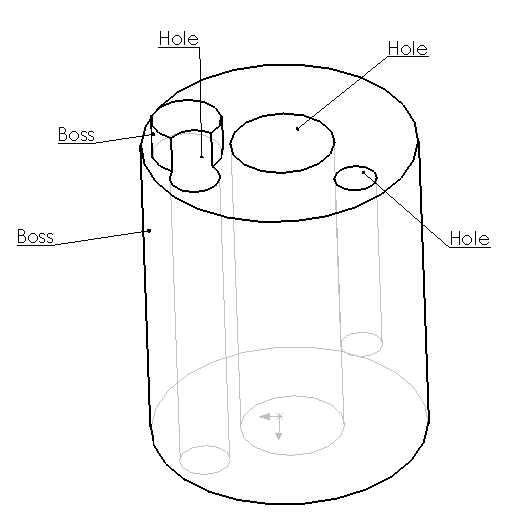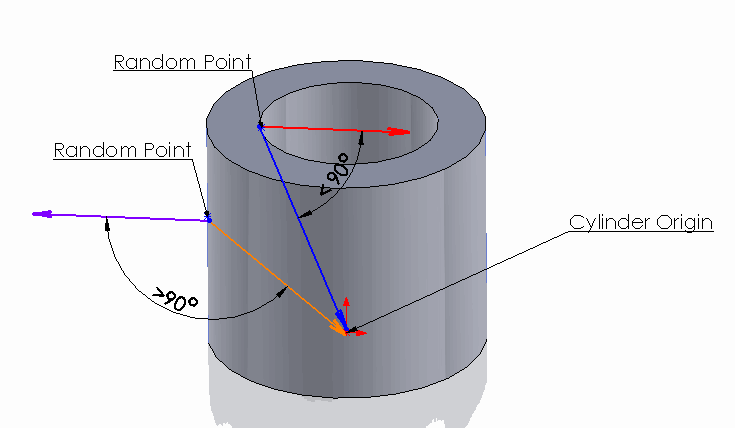Determine if selected face is hole or boss using SOLIDWORKS API
This example demonstrates how to identify if the selected cylindrical face is internal (i.e. hole) or external (i.e. boss) using SOLIDWORKS API.
Select cylindrical face and run the macro. Message box is displayed with the type of the selected face. Macro will work with any face (it is not required for faces to have planar adjacent faces).
Algorithm
This macro identifies if the face is hole or boss based on the direction of the normal of the face. The normals for the holes are always directed towards the cylinder axis, while the normals for the bosses always directed outwards of the cylinder axis.
Macro finds random point on the face (in this example this is a middle between U and V parameters of the face) and normal at this point. After, the vector between this point and the cylinder origin is calculated. If the angle between this vector and normal is less than 90 degrees (PI / 2) than the normal is directed towards the cylinder axis which means that the face is a hole, otherwise (if angle is greater than 90 degrees (PI / 2)) the face is external (boss).
Please see image below:
using SolidWorks.Interop.sldworks; using SolidWorks.Interop.swconst; using System.Runtime.InteropServices; using System; namespace HoleOrBoss.csproj { public partial class SolidWorksMacro { public void Main() { IModelDoc2 doc = swApp.IActiveDoc2; if (doc != null) { IFace2 face = doc.ISelectionManager.GetSelectedObject6(1, -1) as IFace2; if (face != null) { if (IsHole(face)) { swApp.SendMsgToUser("Selected face is hole"); } else { swApp.SendMsgToUser("Selected face is boss"); } } else { throw new Exception("Face is not selected"); } } else { throw new Exception("No document opened"); } } private bool IsHole(IFace2 face) { ISurface surf = face.IGetSurface(); if (surf.IsCylinder()) { double[] uvBounds = face.GetUVBounds() as double[]; double[] evalData = surf.Evaluate((uvBounds[1] - uvBounds[0]) / 2, (uvBounds[3] - uvBounds[2]) / 2, 1, 1) as double[]; double[] pt = new double[] { evalData[0], evalData[1], evalData[2] }; int sense = face.FaceInSurfaceSense() ? 1 : -1; double[] norm = new double[] { evalData[evalData.Length - 3] * sense, evalData[evalData.Length - 2] * sense, evalData[evalData.Length - 1] * sense }; double[] cylParams = surf.CylinderParams as double[]; double[] orig = new double[] { cylParams[0], cylParams[1], cylParams[2] }; double[] dir = new double[] { pt[0] - orig[0], pt[1] - orig[1], pt[2] - orig[2] }; IMathUtility mathUtils = swApp.IGetMathUtility(); IMathVector dirVec = mathUtils.CreateVector(dir) as IMathVector; IMathVector normVec = mathUtils.CreateVector(norm) as IMathVector; return GetAngle(dirVec, normVec) < Math.PI / 2; } else { throw new NotSupportedException("Only cylindrical face is supported"); } } private double GetAngle(IMathVector vec1, IMathVector vec2) { return Math.Acos(vec1.Dot(vec2) / (vec1.GetLength() * vec2.GetLength())); } public SldWorks swApp; } }

